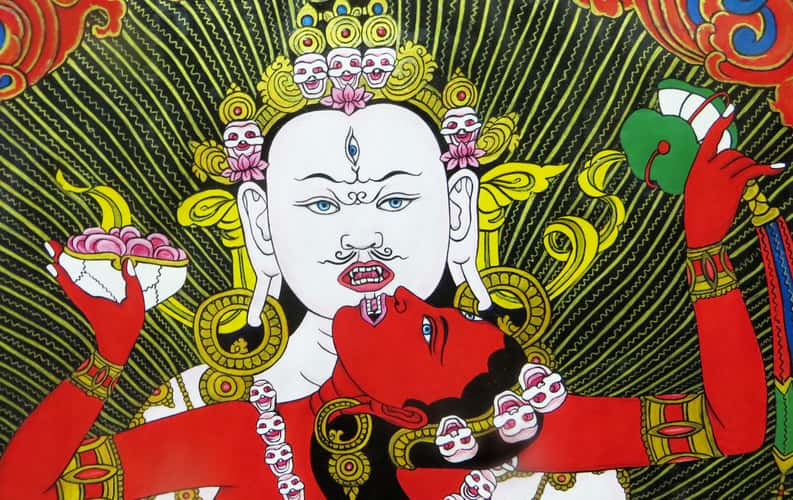What are tantric Buddhist & What are the main beliefs?
Sometimes called Deity yoga, Tantric Buddhism provides a path to enlightenment through identity with Tantric deities. With the guidance of a guru, the yogi uses rituals, meditation, visualization through mandalas and other practices to realize him/herself as a deity.
Tantra (/ˈtæntrə/; Sanskrit: तन्त्र, lit. ’loom, weave, warp’) are the esoteric traditions of Hinduism and Buddhism that developed in India from the middle of the 1st millennium CE onwards. The term tantra, in the Indian traditions, also means any systematic broadly applicable “text, theory, system, method, instrument, technique or practice”. A key feature of these traditions is the use of mantras, and thus they are commonly referred to as Mantramārga (“Path of Mantra”) in Hinduism or Mantrayāna (“Mantra Vehicle”) and Guhyamantra (“Secret Mantra”) in Buddhism.
Starting in the early centuries of the common era, newly revealed Tantras centering on Vishnu, Shiva or Shakti emerged. There are tantric lineages in all main forms of modern Hinduism, such as the Shaiva Siddhanta tradition, the Shakta sect of Sri-Vidya, the Kaula, and Kashmir Shaivism.
In Buddhism, the Vajrayana traditions are known for tantric ideas and practices, which are based on Indian Buddhist Tantras. They include Indo-Tibetan Buddhism, Chinese Esoteric Buddhism, Japanese Shingon Buddhism, and Nepalese Newar Buddhism.
Tantric Hindu and Buddhist traditions have also influenced other Eastern religious traditions such as Jainism, the Tibetan Bön tradition, Daoism, and the Japanese Shintō tradition.
Certain modes of non-Vedic worship such as Puja are considered tantric in their conception and rituals. Hindu temple building also generally conforms to the iconography of tantra. Hindu texts describing these topics are called Tantras, Āgamas, or Samhitās. In Buddhism, tantra has influenced the art and iconography of Tibetan and East Asian Buddhism, as well as historic cave temples of India and the art of Southeast Asia.

The Tantras:
Tantra is a Hindu and Buddhist philosophy that affirms all aspects of the material world as infused with divine feminine power. It is rooted in sacred instructional texts, composed from around the sixth century onwards, called the Tantras. Many describe rituals that transgress social and religious conventions within mainstream Hinduism and Buddhism.
Some Tantras describe sexual rites for achieving enlightenment. These can be understood both literally and symbolically. If taken literally, a couple assumes the role of deities in sexual union, the woman often being the focus of worship. When interpreted symbolically, a practitioner visualizes this union within their own body, the deities symbolizing qualities such as wisdom and compassion. The Tantra pictured here, composed in ancient Sanskrit, recommends the union of the ‘thunderbolt’ and ‘lotus’, which can be understood as the phallus and vulva.
The Tantras were first translated into English in the 19th century when India was under British rule and was reductively misinterpreted by many Christian missionaries, Orientalist scholars, and colonial officials. Such distortions went on to inform current misunderstandings of Tantra in the West as an orgiastic ‘cult of ecstasy’.
The role of sex
Erotic imagery not only plays an important role in Tantra but also in mainstream Hinduism. According to Hindu belief, the creation of the universe is believed to be a product of divine sexual union, and the goals of a fulfilling and righteous life are not only duty (dharma), prosperity (Martha), and liberation (moksha), but also desire (kama).
During the medieval period in India, erotic carvings of couples (mithuna) were considered to bring good fortune and protection.
Erotic mithuna (‘couple’) sculpture:
“sculpture Red sandstone, India, late 10th century. Funded by the Brooke Sewell Permanent Fund.”
couple sculpture would have once been positioned on the wall of a Hindu temple. Two lovers caress each other, their lips about to touch. There is nothing particularly Tantric about this sculpture. An architectural manual written in about AD 900 includes the following instruction: ‘kama is the root of the universe … erotic sculpture panels should be mounted [in temples] to delight the general public.’
Painting of a couple having sex:
“Possibly Bikaner, Rajasthan, India. Gouache on paper, about 1690.”
An image of a courtly-looking couple painted in the 17th century is one of a series illustrating sexual positions.
Such images were influenced by ancient texts dedicated to kama, such as the Kama Sutra, written by Vatsyayana around the AD 200s. According to this text, sexual pleasure for those living at court should be a cultivated ‘art’. Contrary to Western misperceptions, Tantra had little to do with the science of pleasure outlined in the Kama Sutra, which was composed before the rise of Tantra and was guided by Hindu beliefs.
Tantra introduced a different idea. Rather than seeking pleasure as an end in itself, Tantra taught practitioners to harness the body and sensuality to unite with divinity and attain transformational power. Tantric sexual rites were also distinguished by their transgressive nature, engaging with the taboo rather than repressing it.
In Tantric texts, women are described as embodiments of Shakti (divine feminine power), and this power could be ritually accessed through their sexual fluids. To venerate the yoni (vulva) was to venerate the source of creation itself. When they engaged in sexual rites, practitioners imagined themselves as divine incarnations of Shakti and the Hindu god Shiva.
Tantric Buddhism | Tantric yoga:
While Tantric sexual rites could be carried out literally, by a couple assuming the roles of Shiva and Shakti, they could also be imagined as an internal union of deities using visualization exercises. The goal of Tantric yoga is to awaken an individual’s inner source of Shakti, located at the base of the spine and visualized as the serpent goddess Kundalini. Around her is a network of energy centers (chakras), each of which contains a deity. Through breath control and complex postures, Kundalini rises the body.
Yogi with chakras:
“Rajasthan, northwest India, the early 1800s.”
In this painting, a yogi experiences bliss as Kundalini (represented as a white coil at the base of the spine) prepares to move upwards through the chakras. As she comes into contact with each deity within, she infuses them with power, enabling the yogi to reach higher spiritual planes. At the crown of the head resides Shiva, embodying pure consciousness (represented here by a multi-petaled lotus). They unite, enacting a sexual rite within the yogi’s own body. Their union triggers an awakened, liberated state and is believed to grant access to various powers, from long life to invulnerability.
Divine union:
The rise of Tantra led to a new school of Tantric Buddhism known as Vajrayana or the Path of the Thunderbolt, which had spread across Asia by the eighth century, with a particularly strong hold in Tibet. According to Vajrayana teachings, the qualities of wisdom (prajna) and compassion (karuna) must be cultivated on the path to enlightenment. Tantric texts and images represent these qualities as a goddess (wisdom) and a god (compassion) in sexual union.
In Tibet this is known as yab-yum, meaning ‘father-mother’. Devata (Deity) yoga is a Vajrayana practice that involves visualizing and fully internalizing these deities in union within the body, to embody their supreme qualities. This practice inspired the creation of yab-yum images, which are used to support meditation.
Thangka (painting on silk) depicts Chakrasamvara in union with Vajrayogini. Tibet, 18th century:
The Tibetan thangka shows two deities embracing, Chakrasamvara and Vajrayogini. Their red-rimmed, wild eyes and laughing, fanged mouths suggest their immense power. The role of such wrathful imagery highlights the Tantric belief that only the most ferocious deities can abolish the obstacles to enlightenment. They are deities to be adored as well as emulated.
The image evokes the interplay of the feminine (wisdom) and masculine (compassion) principles that must be internalized. Both deities hold up weapons with which they destroy misplaced pride, attachment, anger, ignorance, and worldly desire. Yab-yum images such as this were commissioned to aid visualizations during Devata yoga. The practitioner internalizes the deities and recognizes in themselves both the female and male principles, merging the two within their own body. Emptied of ego, the practitioner achieves self-deification.
Hevajra Tantra. Palm leaf, Bengal, India, 15/16th century:
The Hevajra Tantra dates to the late AD 800s and describes the benefits of engaging in sexual rites to elevate and transcend desire itself. On the folio below are the words: ‘by passion, the world is bound; by a passion to it is released.’ Sexual rites should not be ‘taught for the sake of enjoyment, but the examination of one’s thought, whether the mind is steady or wavering.’ Even celibate monks and nuns could engage with this method by internalizing deities in union through visualization.
Sex and death in Tantric Buddhism:
During the 19th century, Bengal in eastern India was an early Tantric center as well as the nucleus of British rule. Tantra informed the way many Christian missionaries and colonial officials imagined India, as a subcontinent apparently corrupted by sexual depravity.
Chinnamasta (‘She Whose Head is Severed’), Lalashiu Gobin Lal. Hand-colored woodblock, Kolkata, India, late 19th century.
in Tantric Buddhism, Their misconceptions were embodied by seemingly demonic Tantric goddesses such as Chinnamasta, pictured. Here she clutches her severed head, which drinks one of the three streams of blood spurting from her neck. The other two streams nourish her attendants. A revolutionary Bengali text described Chinnamasta’s radical potential as a symbol of the Motherland, decapitated by the British but preserving her vitality by drinking her blood, representing an ideal of heroic fearlessness and self-sacrifice.
The image communicates the inseparability and interdependence of sex, life, and death at the heart of the human experience. She stands upon the copulating deities of love and desire (the god Kama and goddess Rati) as if to suggest that she transcends desire while also being fundamentally supported by it. Rati is shown on top of Kama, signaling the superiority of the female principle within Tantra.
Beyond sex in Tantric Buddhism:
Once attacked by colonial officials as perverse, since the 1960s Tantra as a tradition has been celebrated as the ‘art of sexual ecstasy in the West. Although Tantric visual culture features a proliferation of erotic images and many Tantric texts include descriptions of sexual rites, these makeup only a small proportion of the content. While kama (‘desire’) was a principal goal of life according to mainstream Hinduism, one of the central aims of Tantric sex was to unite with divinity, rather than to seek pleasure for its own sake. Tantra validates the body and the sensual as a means of achieving liberation and generating power.
Sexual rites could be imagined as an internal union of deities or carried out literally by a couple assuming the roles of deities. This exhibition seeks to provide the interpretive tools for understanding how these tensions between literal and symbolic registers co-exist and are part of what makes Tantra unique.
World Religions
Read also:
What Is Hinduism religion Origins, Facts & Beliefs?
Study Buddhism What is the study of Buddhism?
Anima mundi | What’s the meaning of anima mundi?
Faith of Unity Church | History, Founder, Beliefs, Book and More..
Sufi orders | All about Sufi orders with their geographical extent



